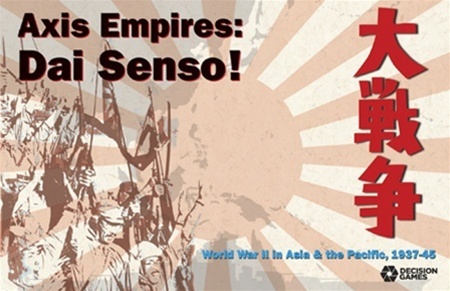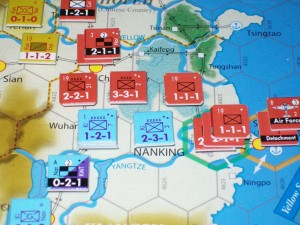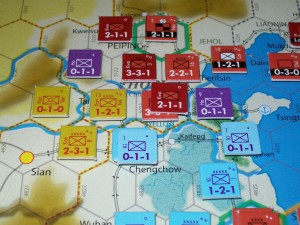Gaming the Sino-Japanese War (I)
- By Peter Harmsen
- 16 October, 2013
- 35 Comments
 Since World War II ended in 1945, historians and laypeople alike have strived to make sense of the event, place it into a larger context and grasp its lasting significance. They have done so not just through historical accounts, but also in various works of fiction. Many have resorted to wargames, which have the advantage of making the student an interactive player, giving him or her a better intuitive feel for the choices that historical actors faced. These wargames, or simulations, come mainly in computerized form, but the original bordgame genre from the pre-PC era continues to command a significant and loyal following. An example of the latter is Axis Empires: Dai Senso! from Decision Games (pictured above), which deals with the entire conflict in the Asia-Pacific from 1937 to 1945 at a strategic level. We talked to Thomas Prowell, one of the game’s designers, to get an idea of the thoughts behind the game, and bring the first part of a two-part interview below. Photos from actual gameplay are provided by ER Bickford, whose detailed photographic record of a campaign game spanning the entire eight-year war can be found here.
Since World War II ended in 1945, historians and laypeople alike have strived to make sense of the event, place it into a larger context and grasp its lasting significance. They have done so not just through historical accounts, but also in various works of fiction. Many have resorted to wargames, which have the advantage of making the student an interactive player, giving him or her a better intuitive feel for the choices that historical actors faced. These wargames, or simulations, come mainly in computerized form, but the original bordgame genre from the pre-PC era continues to command a significant and loyal following. An example of the latter is Axis Empires: Dai Senso! from Decision Games (pictured above), which deals with the entire conflict in the Asia-Pacific from 1937 to 1945 at a strategic level. We talked to Thomas Prowell, one of the game’s designers, to get an idea of the thoughts behind the game, and bring the first part of a two-part interview below. Photos from actual gameplay are provided by ER Bickford, whose detailed photographic record of a campaign game spanning the entire eight-year war can be found here.
Q: Dai Senso is rather unique in positioning China as the central prize which the players must vie for. Do you see this as a more accurate reflection of reality than more traditional Pacific War games?
A: Well, I wouldn’t say that Dai Senso is “a more accurate reflection of reality” than other Pacific War games. These are all games, after all! I would say that, when we set out to design Dai Senso, we really wanted to capture the war as it was perceived from the Japanese point-of-view. (This was the same approach we had taken with its sister game, Totaler Krieg, which was designed first and replays the European war from Germany’s point-of-view.) We felt this would offer a fresh perspective on the war , as other Pacific War games concentrate on the 1941-45 naval war, and they tend to look at the war from an American perspective. Since the game focuses on Tokyo’s imperial war aims, China naturally becomes a much bigger player in the game.
Q: In Dai Senso, China is treated not as one country, but many. This is a very original design decision. What motivated it? Was it a difficult decision to make?
A: I’m glad you called that out — that was a design decision that occurred fairly early on, but after it happened, it really opened up the game and the possible stories we could tell. There were two factors that motivated it. The first, of course, it that any reading of China’s history from the warlord era to the 1930s should reveal just how fragmented the country really was. But the second factor was a game design consideration. The unpredictability of minor countries was a key feature of the Totaler Krieg game system, and back when we only had “one” China on the map we felt that our Pacific game (which didn’t have an official title yet) was really lacking something — the situation was too static and there weren’t enough surprises of the sort we thought the game should have. Breaking China into several smaller countries allowed us to get some of that unpredictability into the game. Now instead of worrying about “China” as one entity, you as the Japanese player are free to deal with the Nationalist government or Communists separately, and you may be able to negotiate with one of the warlord cliques in the Northern provinces, Sichuan, Sinkiang, or Yunnan.
Once the decision was made, the key design work went into making sure things didn’t get too far out of hand. Early drafts of the game included things like a full-scale Chinese Civil War in the 1930s and ’40s. We found through playtesting that this made it too easy for Japan to win the game. So we had to tamp things down to their current level. But we knew we were on the right course. The idea that China is a single country is a fairly recent notion; even observers at the time recognized its lack of cohesion. This was confirmed to me when I found a wartime map that had the province of SINKIANG called out and bordered off as if it were a separate country from CHINA.
Q: While conventional Pacific War games treat the conflict as an ocean war, Dai Senso seems to place greater emphasis on its character as a struggle over land territory. What was behind that decision?
A: To be honest, this is an artifact of the game being a sister game to Totaler Krieg, which was designed first. The European game was designed with abstract air and naval assets … and while we could have chosen to make those systems more detailed with Dai Senso, we felt like the abstract system was “good enough” for our purposes with a few modifications. For the design team, it was a matter of scale and emphasis: Dai Senso was designed to be a grand strategic level game, and the kind of air/naval detail that players expect in their Pacific War games are really operational level or tactical considerations. We also felt there were many other good Pacific War games that tell that air/naval story really well … again, we wanted to tell a different story with Dai Senso.
We do realize that this abstract air/naval system is probably the one thing that has turned a lot of gamers “off” to Dai Senso. Gamers like to play with ships and planes. So, one of the projects I’m working on is the Axis Empires Expansion Kit, which will add a more detailed air/naval combat system to the game for those players who want it. (To be continued.)

 Copyright © 2025
Copyright © 2025
Leave a Reply